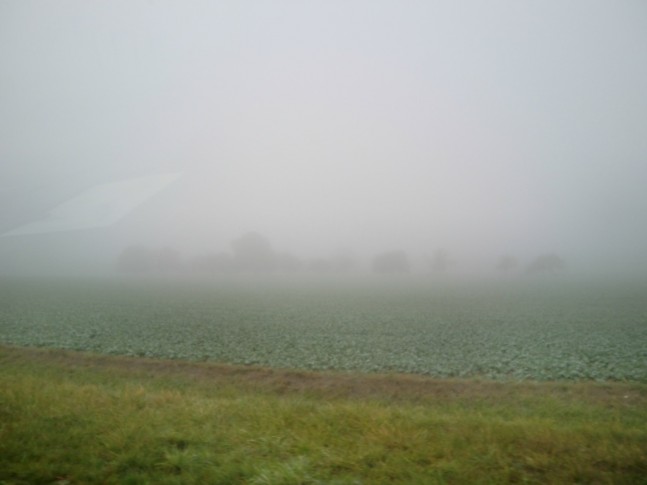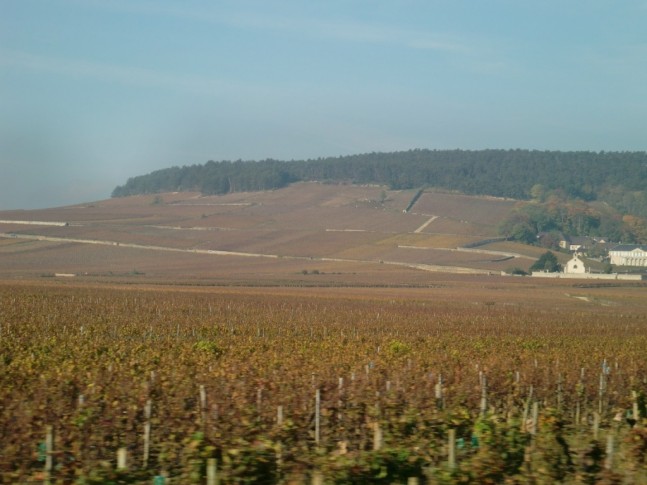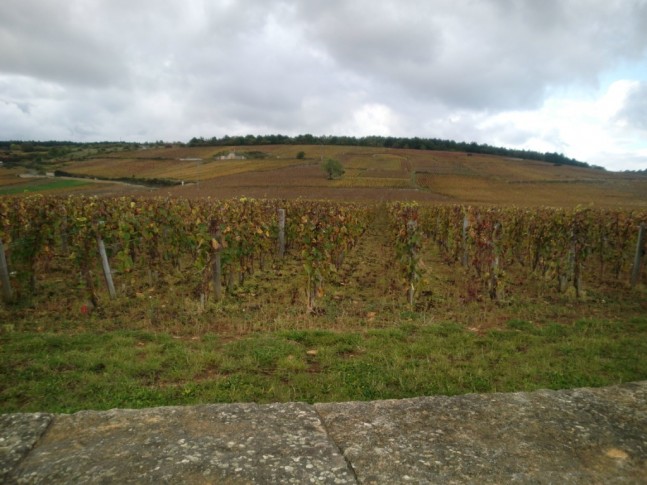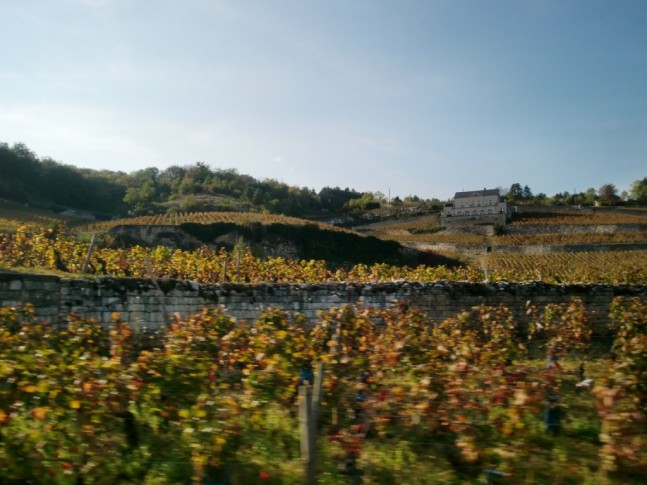02/11/2011 PART 2 of the Burgundy Series
As my guide, Elohim Balest of Alter&Go tours and I travelled along the highway from Dijon towards the vineyards of the Côte d’Or, there was aneerie fog that surrounded us.
Apparently, this is not uncommon at all in Burgundy to have a cloud of cold air come down from the top slopes. It occurred to me that frost in the spring is a big problem here in Burgundy. This is the enemy that grapegrower’s fear – the spring frost that kills the baby buds of the vine that will bring forth fruit for the next harvest.

Burgundy fog
Fortunately for us, as we travelled further down the highway, the fog lifted and the sun came out to reveal something magical. There is a reason why the vineyards of Burgundy are called the Côte d’Or or the fields of gold. It is because when the season segues from summer to autumn, the vine leaves would brown and what you get would be a mosaic of different coloured fields that browned at different time.

Burgundy Fields of Gold
Elohim explained to me the reason for the different appellations of wine from Bourgogne, Village, 1er Cru and Grand Cru. More than 600 years ago, the Cistercian monk in Burgundy noticed different plots of land that grew grapes which tasted better than others.
This led them to label each plot with names. This began the earliest concept of terrior. This must have been possible during that time as the monks must have used the same fermentation process for each parcel and realised over a long period of time which vineyards produced consistently good grapes.
This wisdom of the elders has been passed on to the vignerons today. Today, we have the vineyards planted on the flat land producing Bourgogne and village designations. Most of the 1er Cru is situated on top of the slopes and the Grand Cru vineyards are situated either at the top or in the middle of the slopes.

Burgundy - overlooking the Chambolle Musigny vineyards
There is a very good reason for that. Slopes are favoured in the old world because it provides good drainage. Water runs off better on slopes and limits the vigour of the vines. Although irrigation is not allowed here, the rainfall is about 700mm/year. Most of the best vineyards (exceptions would be Corton-Charlemagne which has a portion facing west which why the chardonnays there are riper) are south-east facing to catch the morning sun. In Burgundy, warmth for the vines is very much sought after in a region that is often chilly.
The soil is also plays a very important role in the vines. This consists of lots of white limestone and clay. The limestone is vital in acting as “mirrors” to reflect light on the vines in the days. Usually, the better vineyards are warmer, which leads to better quality in general.
The reason for many of the Grand Cru vineyards being on mid-slope is due to the fact that there are pockets of clay down the bottom of the slope that is friable and allows the vine roots to dig deep into the earth. Also, the clay retains a good amount of water in the soil that acts as a reserve of water in years where water is scarce.
It is interesting to note that as you travel along the Côte d’Or, from Côte de Nuits to Côte de Beaune, there is a noticeable change in the structure of the soil from limestone clay to a more granite base soil. This change in the soil is the reason why most of the Grand Cru reds are in the Côte de Nuits and most of the Grand Cru whites are in the Côte de Beaune. Thinking deeper about this, this change in soil composition is seen from Champagne to Provence where we have chalk soils in Champagne and granitic soils in Beaujolais and the Rhône.
I pointed out to Elohim about how different the soils were in Bordeaux in which he responded quickly that the word “Bordeaux” is prohibited in Burgundy (I would later receive the same caveat from others about using the word “Bordeaux” here). There is an on-going rivalry between the Bordelais and the Burgundians when it comes to wine and culture. The Burgundians do not share the same philosophy with Bordeaux concerning their big chateaus and fancy chais (barrel rooms).
It seems simple enough that if one were to choose a bottle of Burgundy with the words Grand Cru or 1er Cru on it, the wine would be great.
Unfortunately, that is not the case here in Burgundy. Vintages here in burgundy are difficult and it is said that in a decade, there is usually one great vintage.

Burgundy - The many "Clos" - closed-wall-vineyards of Burgundy
The dangers of rain causing rot and diluting the berries, hail that can damage the grapes, spring frost that can hurt yields; all these contribute to the finicky vintages that Burgundy has produced over the last few years.
Regardless of what is on the label, the most important indicator of quality, always, is tasting the bottle. If you don’t have that opportunity to taste a bottle before opening, then the reputation of the producer is the next best thing.
Producers like Claude Dugat, Domaine Lécheneaut, Méo-Camuzet, Alex Gambal, Comte-Lafon, Liger-Belair, Domain Dujac, Jean Grivot, Denis Mortet, Sylvain Pataille, Etienne Sauzet, Francois Raveneau, Emmanuel Rouget, Hérve and Georges Roumier always garner big prices every year. They have been seen to be able to produce good wines even in difficult vintages.
Usually, a Bourgogne quality level wine from them is charged as much as a 1er Cru from other growers because the level of quality is that of a 1er Cru.
From speaking to several people in the area and tasting different vintages, I gathered more information about the vintages in general over the last ten years.
Vintage Information:
2000 and 2001 were rainy which gave lots of volume and juice, thus diluting the wine. In 2000, it rained a week before harvest.
2002 and 2003 were not cold enough and the acid was lacking. This affects long term cellaring.
2004, 2006 and 2008 were affected by odium and fruit was lost. Acid was a problem in 2008
2005 was sunny and had a balanced vintage in tannins, acid and sugar.
2007 had good balance in acid and sugar levels.
2009 had a lot of sun and no rain. Probably the best vintage of the last decade.
2010 had rain before picking
And what about this year’s vintage? Picking started at the end of August, about 3 weeks before the usual date. It rained two months before picking which is a good thing because this provides water to the vines to produce grapes. It was very sunny. So the verdict has still yet to be out but from word of mouth, it seems we are looking at a vintage that could be amazing this year but we are still waiting for the word.
Next in the series, the story behind Pinot Noir, philosophy of the Burgundians and some tasting notes.
|
|
Tweet |





One comment to Sommelier Shalom Chin Burgundy Blog – Part 2 | Comments Feed
Hi, this weekend is pleasant in support of me, for the reason that this point in time i
am reading this fantastic informative article here
at my home.
The comments are closed.